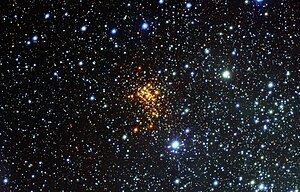Westerlund 1-20
Coordinates:  16h 47m 04.70s, −45° 51′ 23.96″
16h 47m 04.70s, −45° 51′ 23.96″
| Observation data Epoch J2000 Equinox J2000 | |
|---|---|
| Constellation | Ara |
| Right ascension | 16h 47m 04.69s[1] |
| Declination | −45° 51′ 23.9″[1] |
| Characteristics | |
| Evolutionary stage | Red supergiant
|
| Spectral type | M3[2] - M6I[3] |
| Apparent magnitude (J) | 6.378 |
| Apparent magnitude (H) | 4.381 |
| Apparent magnitude (K) | 2.61 |
| Details | |
| Radius | 858±48[2] R☉ |
| Luminosity | 101,000±13,000[2] L☉ |
| Temperature | 3,284 - 3,550[2] K |
| Other designations | |
Westerlund 1 W20, Westerlund 1 BKS D, 2MASS J16470468-4551238, Gaia EDR3 5940106007092341120 | |
| Database references | |
| SIMBAD | data |
Westerlund 1-20 (abbreviated to Wd 1-20 or just W20) is a
largest stars discovered so far. This corresponds to a volume 899 million times bigger than the Sun. If placed at the center of the Solar System, the photosphere of Westerlund 1-20 would almost reach the orbit of Jupiter
.

The star is classified as a luminous cool
supergiant emitting most of its energy in the infrared spectrum.[6] W20 occupies the upper right corner of the Hertzsprung-Russell diagram. Using the effective temperature of 3,500 K,[1] the bolometric luminosity of 126,000 L☉[1] and the solar effective temperature of 5,772 K,[7] its radius can be calculated using the Stefan-Boltzmann law.[a]
Westerlund 1-20 was observed to have an extended, cometary shaped nebula, similar to the other red supergiant Westerlund 1 W26. It is therefore likely that its morphology was affected by either the intracluster medium or the cluster wind of Westerlund 1.[8] The nebulae of both Westerlund 1-20 and Westerlund 1 W26 are extended outward from the cluster core and most bright at inward direction, indicating the outward cluster wind.[9]
See also
Notes
References
- ^ S2CID 53393926.
- ^ .
- Bibcode:1987A&AS...70..311W.
- ^ .
- S2CID 119465620.
- ^ "Cl* Westerlund 1 W 20". Simbad.
- ^ Williams, D. R. (2013). "Sun Fact Sheet".
- ISSN 0004-6361.


